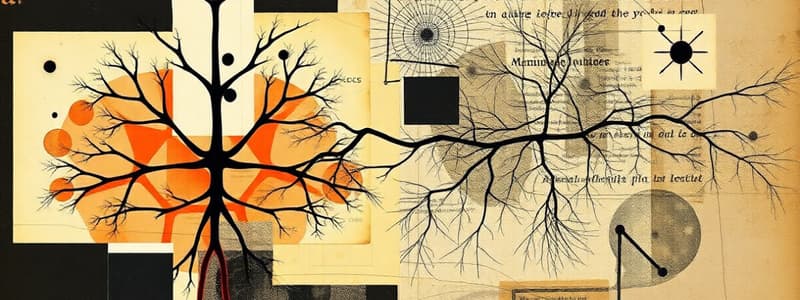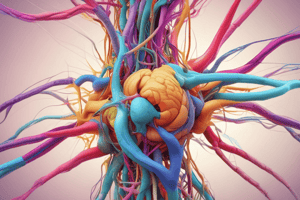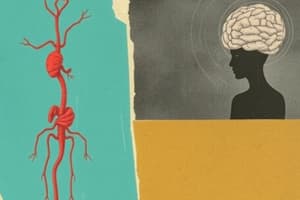Podcast
Questions and Answers
What primary effect does the sympathomimetic nervous system have on the heart?
What primary effect does the sympathomimetic nervous system have on the heart?
- Maintains normal heart rate
- Causes arrhythmias
- Increases heart rate and force of contraction (correct)
- Decreases heart rate
Which neurotransmitter is primarily associated with the parasympathomimetic nervous system?
Which neurotransmitter is primarily associated with the parasympathomimetic nervous system?
- Norepinephrine
- Dopamine
- Epinephrine
- Acetylcholine (correct)
What effect does the active parasympathomimetic nervous system have on the pupils?
What effect does the active parasympathomimetic nervous system have on the pupils?
- Pupil dilation
- Normal pupil size
- Pupil constriction (miosis) (correct)
- Variable pupil size
Which of the following is true regarding the adrenergic receptors?
Which of the following is true regarding the adrenergic receptors?
What is a common effect of the active sympathetic nervous system on blood circulation?
What is a common effect of the active sympathetic nervous system on blood circulation?
In what situation is the inactive parasympathomimetic nervous system likely to be present?
In what situation is the inactive parasympathomimetic nervous system likely to be present?
What class of receptors is primarily associated with pain modulation and addictive behaviors?
What class of receptors is primarily associated with pain modulation and addictive behaviors?
What effect does anticholinergic medication typically have on the body?
What effect does anticholinergic medication typically have on the body?
Flashcards
Sympathetic Nervous System (SNS)
Sympathetic Nervous System (SNS)
Part of the autonomic nervous system that prepares the body for 'fight or flight' responses.
Parasympathetic Nervous System (PNS)
Parasympathetic Nervous System (PNS)
Part of the autonomic nervous system that controls 'rest and digest' functions.
Norepinephrine (Noradrenaline)
Norepinephrine (Noradrenaline)
Neurotransmitter that increases alertness, arousal, and blood pressure.
Alpha Receptors
Alpha Receptors
Signup and view all the flashcards
Beta Receptors
Beta Receptors
Signup and view all the flashcards
Acetylcholine
Acetylcholine
Signup and view all the flashcards
Muscarinic Receptors
Muscarinic Receptors
Signup and view all the flashcards
Nicotinic Receptors
Nicotinic Receptors
Signup and view all the flashcards
Study Notes
Sympathetic Nervous System
- Function: Prepares the body for "fight or flight" responses.
- Neurotransmitters:
- Epinephrine (adrenaline)
- Norepinephrine (noradrenaline): Increases alertness, arousal, and blood pressure.
- Receptors:
- Alpha: Primarily cause vasoconstriction.
- Beta: Increase heart rate and force of contraction (β1), cause bronchodilation (β2).
- Active State:
- Increased heart rate and force of contraction
- Bronchodilation
- Pupil dilation
- Increased blood flow to skeletal muscles
- Decreased blood flow to digestive system
- Increased blood glucose levels
- Increased sweating
- Inactive State:
- Normal resting heart rate
- Normal bronchial tone
- Normal pupil size
- Balanced blood flow distribution
- Normal digestive function
- Stable blood glucose levels
- Normal sweating
Parasympathetic Nervous System
- Function: Responsible for "rest and digest" functions.
- Neurotransmitter: Acetylcholine
- Receptors:
- Muscarinic: Mediate parasympathetic effects (e.g., decreased heart rate, increased secretions).
- Nicotinic: Involved in neuromuscular junction signaling and some CNS functions.
- Active State:
- Decreased heart rate
- Bronchioconstriction
- Pupil constriction (miosis)
- Increased digestive system activity
- Increased salivation and urination
- Decreased blood pressure
- Inactive State:
- Normal resting heart rate
- Normal bronchial tone
- Normal pupil size
- Balanced digestive function
- Normal salivation and urination
- Normal blood pressure
Other Receptors
- Opioid Receptors:
- Location: Primarily in the brain and spinal cord.
- Function: Modulate pain, reward, and addictive behaviors; influence autonomic functions.
- GABA Receptors:
- Location: Ubiquitous in the brain and spinal cord.
- Function: Inhibit neuronal activity, leading to calming effects, muscle relaxation, and reduced neuronal excitability.
Anticholinergic Substances
- Mechanism: Block acetylcholine, reducing parasympathetic nerve impulses.
- Effects: Drying of bodily fluids, smooth muscle relaxation, pupil dilation.
- Uses: Treat overactive bladder and Parkinson's disease.
- Note: Does not activate the sympathetic response; it reduces parasympathetic activity.
Sympathomimetic Substances
- Mechanism: Mimic the effects of the sympathetic nervous system.
- Effects: Increase heart rate, dilate airways, elevate blood pressure.
- Uses: Treat asthma, shock, and certain heart conditions.
Studying That Suits You
Use AI to generate personalized quizzes and flashcards to suit your learning preferences.
Description
This quiz covers the functions, neurotransmitters, and effects of the sympathetic and parasympathetic nervous systems. Understand how each system prepares the body for different states, such as 'fight or flight' vs. 'rest and digest'. Test your knowledge on the associated receptors and bodily responses.




